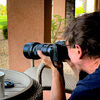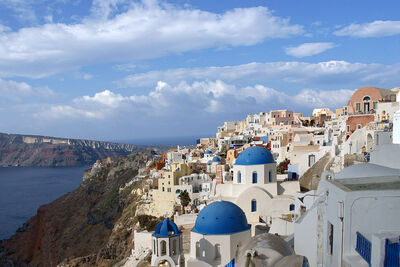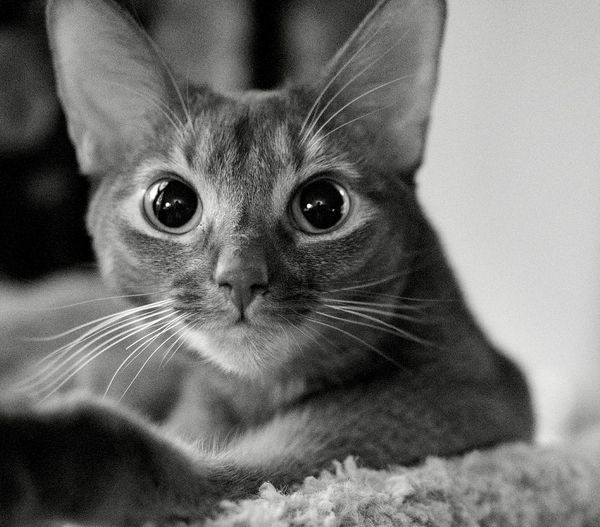Why Fast Lenses?
Jan 30, 2021 14:39:52 #
Urnst
Loc: Brownsville, Texas
burkphoto wrote:
> better bokeh, if important for your style of ... (show quote)
Thanks. Your answer makes sense for pros and those who shoot indoor sports. But I don't agree that, for others, the added expense, size and weight make sense in most cases.
Jan 30, 2021 14:41:44 #
Consider listening to the successful photographers when they talk about the equipment they use.
Jan 30, 2021 15:17:17 #
Leitz
Loc: Solms
Urnst wrote:
Fast prime and zoom lenses are huge, heavy, and expensive. What with autofocus and high ISOs with digital cameras why is such value put on having a fast lens? Slower can be just as sharp, albeit with a little less bokeh.
A slower lens will not have less bokeh than a faster lens. Won't have more, either.
Jan 30, 2021 15:32:31 #
Urnst wrote:
Fast prime and zoom lenses are huge, heavy, and expensive. What with autofocus and high ISOs with digital cameras why is such value put on having a fast lens? Slower can be just as sharp, albeit with a little less bokeh.
I just joined UHH recently also. I’m using my dad’s old Canon T2i from 2010, the two kit lenses it came with, a Tokina telephoto up to 400mm, and an Olympus 50mm 1.8 lens. That’s enough for me to work with as I continue to learn the art, and I’ve been surprised with the results as I continue to improve with the older technology. One of these days I’ll invest in something more advanced for low light and Milky Way pics but for now I’m enjoying the journey. Thanks to the UHH community for supportive and Honest feedback that can only come from photographers.
Jan 30, 2021 15:41:36 #
Leitz wrote:
A slower lens will not have less bokeh than a faster lens. Won't have more, either.
Wide open there will be a slight difference in DOF if the aperture difference is a full stop but you probably won't be able to see it in an image.
Anything less than a full stop and you will see it very clearly in your bank account.
Jan 30, 2021 16:10:06 #
flyboy61
Loc: The Great American Desert
selmslie wrote:
Wide open there will be a slight difference in DOF if the aperture difference is a full stop but you probably won't be able to see it in an image.
Anything less than a full stop and you will see it very clearly in your bank account.
Anything less than a full stop and you will see it very clearly in your bank account.

Very true! BUT!!! The GEE WHIZ factor of a lens is not to be ignored. Carrying the very latest Whiz Bang creation of the camera manufacturer's Marketing department looks cool, and people will think you know what you are about!
 The fact is, that with adjustable ISO and some small acquaintance with your gear and photographic principles, which due to the laws of Physics, haven't changed much in a Century or more, pleasing Bokeh is attainable with almost any equipment.
The fact is, that with adjustable ISO and some small acquaintance with your gear and photographic principles, which due to the laws of Physics, haven't changed much in a Century or more, pleasing Bokeh is attainable with almost any equipment. I have a friend who works himself into a lather because his photos have NOISE in car doors and other large, monochrome areas. Red and blue were his worst things!
Of course, he didn't come from the Dinosaur Generation, where grain(noise) was a fact of life, and we ignored it for the most part. Another acquaintance bought herself a "good" lens after using her kit objective for a while, and told her hubby that the new lens had improved her photography. Not that I am disrespecting the lady's truthfulness, but I suspect the "improvement" was mostly psychological, and/or something to mollify her husband about the purcha$e! Whatever makes you happy, and you can afford...especially if there is a slim to no chance of ever becoming a Professional with your own Adorama video channel!

Jan 30, 2021 16:20:55 #
The surest way to corrupt a novice is to explain the importance of professional grade equipment.
Jan 30, 2021 16:31:42 #
burkphoto pretty much explained it completely.
If a photographer wants a specific effect to produce a specific image .... be it telefoto reach, amazing creamy bokeh, super-wide field, whatever .... the photographer gets that device or bit of gear which gives that effect. The weight is not an issue. The price is, but not so very much .... A pair of socks is cheaper than a pair of pants, but except for the red Hot Chili Peppers ......
I shoot mountain bike racing sometimes, and mountain bike races often take place in the woods, under a full canopy. I can either use a lot of flash, which is hard to control, or a fast, wide-aperture lens and less or no flash. The fast lens cost a lot .... hard choice.
I used to shoot auto racing. There are some shots you can only get with a lot of reach--a super-zoom telefoto. Buy the lens or don't shoot that shot. it's a choice.
Some folks shoot intimate portraits and need a lot of bokeh to make the subject stand out. There is no alternative---get a wide-aperture lens or don't get the shot. Make the choice.
Some folks do street photography, and the most important thing is that a lens be light and versatile---the photographer needs ot be agile, flexible, adaptable, and a big heavy prime would be a terrible choice, while a lightweight, possibly slightly less sharp telefoto---a 24-105 (not a cheap lens,) an 18-135 or even 55-200---both "kit" lenses---might be the perfect tools.
Choose the tool for the job. if you can do the job with a screwdriver, get a screwdriver. But realize, that to weld you need a welder, and all the kit ... yes it costs more, is heavier, and bulkier than a screwdriver. But the screwdriver won't run a bead.
If a photographer wants a specific effect to produce a specific image .... be it telefoto reach, amazing creamy bokeh, super-wide field, whatever .... the photographer gets that device or bit of gear which gives that effect. The weight is not an issue. The price is, but not so very much .... A pair of socks is cheaper than a pair of pants, but except for the red Hot Chili Peppers ......
I shoot mountain bike racing sometimes, and mountain bike races often take place in the woods, under a full canopy. I can either use a lot of flash, which is hard to control, or a fast, wide-aperture lens and less or no flash. The fast lens cost a lot .... hard choice.
I used to shoot auto racing. There are some shots you can only get with a lot of reach--a super-zoom telefoto. Buy the lens or don't shoot that shot. it's a choice.
Some folks shoot intimate portraits and need a lot of bokeh to make the subject stand out. There is no alternative---get a wide-aperture lens or don't get the shot. Make the choice.
Some folks do street photography, and the most important thing is that a lens be light and versatile---the photographer needs ot be agile, flexible, adaptable, and a big heavy prime would be a terrible choice, while a lightweight, possibly slightly less sharp telefoto---a 24-105 (not a cheap lens,) an 18-135 or even 55-200---both "kit" lenses---might be the perfect tools.
Choose the tool for the job. if you can do the job with a screwdriver, get a screwdriver. But realize, that to weld you need a welder, and all the kit ... yes it costs more, is heavier, and bulkier than a screwdriver. But the screwdriver won't run a bead.
Jan 30, 2021 16:46:13 #
My approach was to build up a stable of older pro-level Nikkor AF-D primes that are faster (1.4, 1.8, 2.0) than the best zooms today which top-out at 2.8. So based on the conventional wisdom, my primes are potentially superior to the so-called Holy Trinity everyone salivates over in term of noise and depth-of-field with outstanding build-quality and optics whose output would I put toe-to-toe with anyone's. Plus these lens can be had for $300 or less a copy.
Jan 30, 2021 16:53:18 #
If you have a prism viewfinder, fast lenses give you a much better (brighter) view.
Jan 30, 2021 17:05:24 #
Leitz
Loc: Solms
selmslie wrote:
Wide open there will be a slight difference in DOF if the aperture difference is a full stop but you probably won't be able to see it in an image.
Anything less than a full stop and you will see it very clearly in your bank account.
Anything less than a full stop and you will see it very clearly in your bank account.
The OP seems to think that bokeh is a quantity, rather than a quality.
Jan 30, 2021 17:11:38 #
Leitz wrote:
The OP seems to think that bokeh is a quantity, rather than a quality.
And bokeh is too often over-analyzed. The question should be "Overall, does the image please the viewer?"
Jan 30, 2021 17:22:18 #
When I shoot with my mirrorless, I can make my view finder as bright as needed, even with my f/1.2 lenses.
Jan 30, 2021 19:46:47 #
When I was just getting into digital from film many years ago, I thought the same thing - after shooting 400 ASA film, why would anyone need fast lenses with DSLRs now good to ISO 3200 or higher? I said as much to a pro at the camera store who knew better, but was kind enough (or smart enough) not to argue. Now I know better. Since then I’ve learned how much subject isolation matters and how much difference there is in IQ when you can shoot that indoor wedding or sports or candids with no flash at ISO 3200 instead of 12,800 (2 stops). I also noticed how that pro was often shooting fast primes instead of zooms. Now I understand that as well. Let me provide an example. Available light, 50 mm f2 wide open at ISO 6400 on a crop Fuji SOOC. Can’t do this at f4 (or even f2.8)
Jan 30, 2021 21:53:00 #
Urnst wrote:
Fast prime and zoom lenses are huge, heavy, and expensive. What with autofocus and high ISOs with digital cameras why is such value put on having a fast lens? Slower can be just as sharp, albeit with a little less bokeh.
Covered in fabulous detail here:
https://www.uglyhedgehog.com/t-683386-1.html
If you want to reply, then register here. Registration is free and your account is created instantly, so you can post right away.






